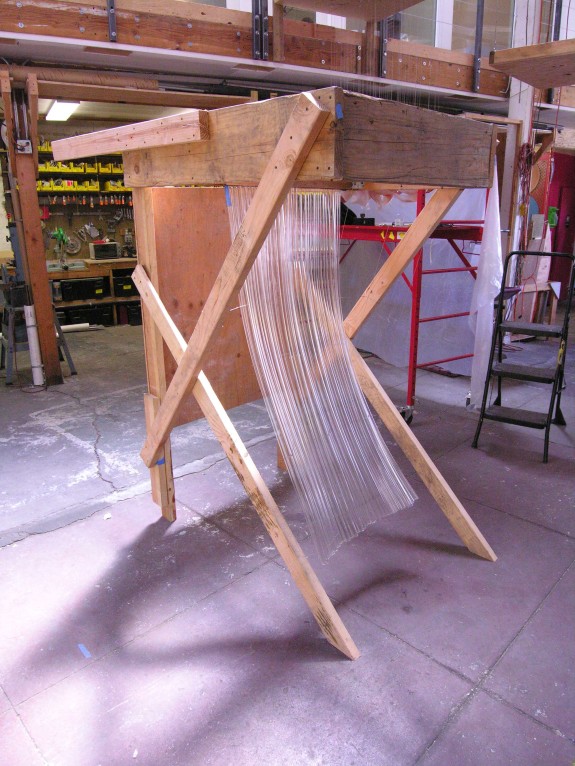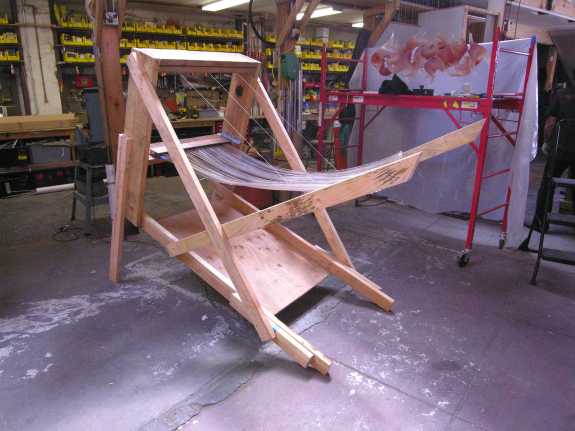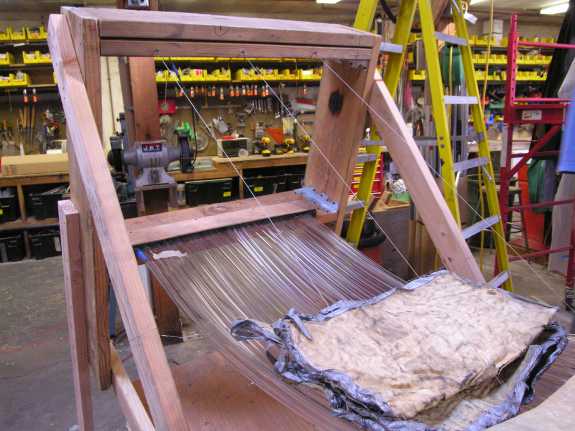All of the six sculptural elements that make up the sculpture in Malaysia ship upside down. When they arrive, they must be inverted before being lifted into place. And some of them are pretty big, up to ten feet in length. So, we fell back on the old fail-safe method we developed on our first project for that Frank Gehry building in Berlin. Each piece gets packed inside a big custom wooden crate and anchored to the crate’s floor. Then we get about four or six strapping youths (save one or two of us who are getting on in years) and simply lift the edge and roll the crate onto its next face. Repeat once more and there is your 180 degree flip. Here’s a dry-run:
Container Dropoff
And another container was parked in our lot this morning. This standard forty-foot container will be loaded with our latest sculpture that is bound for Kuala Lumpur, Malaysia, by ocean freighter. This will of course be only one of many on the boat. Apparently the newest container ship – a monster made for Maersk – can carry 15,000 of these. The container will be taking up all our parking spaces for the next three days while we incrementally load the six sculptural elements. This is what it looked like this morning as Ari and Arlen sipped their morning coffee and directed the trucker’s maneuvers:
Moving Shop
After a recent trip to Japan, I am deeply inclined to pull roots and relocate the studio to Tokyo. Seriously. I was so taken with Japan that I left with a deep sense of regret for all the times that I have flown through Narita, but never taken the opportunity to explore the country. Well, that will never happen again. In fact, I am looking for any opportunity to get back there.
After years and years of thinking about how great it would be to work there, I made the trip to engage the opportunity head on. I had always assumed that it would be a great fit. My work is about nature, technology, minimalism, and architecture. And Japanese culture is deeply reverential when it comes to nature and they make the Germans look like sophomores when it comes to detail and execution. And their approach to the design process is startlingly holistic which plays right into my inclination to integrate sculpture into built spaces. Short story: nearly all my half-baked and altruistic imaginings were ratified on this trip
I was extremely lucky to have met with some incredibly accomplished architects and some of the largest developers in the country. It was humbling. The last person I met was the CEO of a major construction company that was founded in 1610. Yes, 1610. After a pleasant chat about my work, he was really excited to show me a recent exhibition that he had helped to curate in the lobby of the headquarters. They do about eight art shows a year and this one drew heavily from their in-house museum of Japanese woodworking tools. They have their own museum! And it simply was one of several.
It was an overview of how traditional temples are built using only joinery. Needless to say, it was incredibly cool. And all the exhibition’s display walls were made of clear acrylic and filled with wood shavings from planing huge timbers by hand. They were sheer enough to be nearly transparent and made for beautiful scrims to separate different parts of the show. Perhaps the most cogent example of how heavily the Japanese crush and how they played to my weaknesses was a brief description of how traditional carpentry guilds are organized.
After apprenticing for ten years doing all the low-level tasks, a carpenter begins to lead a small team. When building a temple, he is charged not only with overseeing the work but designing the temple. He drafts the plans and then heads out to the forest to select the timbers that will comprise the elemental components of the building. And because he has an intimate knowledge of the design, especially because he is the one who drew it up, he chooses trees whose natural bends and arcs will help to oppose the forces that pull at the structure of the building.
This is deep. It utterly explodes American banter about design-build firms. Granted that this is traditional lore and that not everything in the Japanese construction industry works like this, but it does seam to suffuse the industry. Said differently, all my friends who are architects in the States are desperate to have their work photographed before the clients and interiors firms can ruin it with unrelated furniture choices and obscene paint palettes. Familiar with this fundamentally adversarial relationship that governs many of the projects on which I participate, the Japanese design culture was a welcome tonic.
Even in my brief conversations with many different people, there was a clear interest in a considered and holistic approach. Without encouragement, they would suggest that my work would need to be considered during the very first schematic phases of the project. Typically, I’m lucky to get a call about a project before the ceiling gets closed on most installations let alone participate in any structural conversations in advance. It was a an invigorating trip and I can’t wait for the chance to work there. And I can’t even begin to write about the ramen joints I sussed out. Unbelievable.
As if you were in Shanghai
As part of prepping content for our new website that should be arriving in about a month, we’ve put together a movie fly-through of the installation. In developing and fabricating this project, we first sculpted the entire sculpture by hand in a custom thermoplastic (heat makes it malleable and then it sets at room temperature) that we cast to include all the little tube ridges of the actual construction. Then we used a digitizing arm to translate these models into the virtual world of CAD. From this virtual model we could extract all the data to build and install the sculpture. Besides being able to track locations down to the millimeter, this allowed us to consider the entire sculpture relative to the building and the viewer without ever having assembled more than about twenty feet of the actual sculpture. This was essential as it was just too big to install more than once. Besides, there’s no way in hell it would have fit in the studio.
So here’s a quick flythrough that gives you a pretty good sense of the sculpture’s scale and what it looks like to actually move through the building with the installation overhead. Short of buying a ticket, this should do the trick.
If soccer fields then why not jumbo jets?
So, after I made that post about the soccer field, dear Arlen sent me a comparative chart of jets. Arlen was clearly one step ahead of me in imagining absurd gargantuan comparisons. So, here we have it again. The Shanghai installation vs. the A380:
Making paper look like glass
We’ve just begun work on a large residential project in Kuala Lumpur and I’ve attached some images of the model below. The sculpture was made with some crazy crepe paper that I found years ago. It’s from Germany and there is nothing else like it. People use it for wrapping and so it has all these terrible patterns. Of course, I want it plain and white, so nobody imports it and my stock is dwindling. Robust and pliable, this paper has excellent modeling properties when wanting to make asymmetrical biomorphic shapes where stretch and twist are essential. And, as is usually the case in my work, the model materials suggest certain kinds of forms. More precisely, the paper wants to do some things and not others. So in an effort to make the most compelling design, the final models often express the best possibilities of that paper. And this particular modeled sculpture is so sensual and the tonal differences in all those layered petals give such a sense of depth that we now have to figure out how to make glass that looks like paper. And if you’re a glass guy, the paper suggests improbable things. Ones you didn’t imagine you could make with the tools you’ve got or that you thought the material couldn’t render. This is good because it forces us to think about how to make what we want rather than how to make what we can. It also gets us into some very interesting and some very troublesome situations. I can’t say we always nail it, but I can say that we don’t repeat our work and that it’s always a challenge.
- View with the jungle to the right and the courtyard to the left.
Absurd comparisons: sculpture vs. soccer
When we were working on the installation for the new InterContinental Hotel in Shanghai late last year, we always said it was about a football field long. When we talked about the piece in abstract terms, it never really sank in just how big the thing was. But when we imagined one element of the sculpture starting at the far end of our shop and heading out the door, across the parking lot, and almost to Mission Street, we decided that perhaps just saying it was 40 meters long didn’t convey the sense of scale.
.
I once said that I wanted to “build sculptures big enough to talk to buildings.” That’s when we started relating it to the sports field. The final piece was 78.2 meters long in its finished twisting and curled layout. Unfurled it was closer to about 220 meters. So, once and for all, we figured we should put the sculpture on that field of play. Here it is:
Getting the old Tubilator 2.1 back in working order
After many months of prep and head-banging, we are ready to stop fabricating test panels to destroy in the name of engineering and start building our installation for Bar Agricole, a new swanky restaurant in San Francisco. We just received a custom draw of extra long borosilicate tubing from one of the last – if not the last – factory in the country. This kind of tubing is typically pulled from a draw furnace several stories up in the air where it passes through a die in the furnace floor that gives it a basic sectional shape. As it falls, the glass begins to cool and curve into a horizontal position and ultimately ends up on a conveyor bed where it is cut into sections. Our tubes are nearly seven feet long and were at the outside limit of what they were willing to produce as the tubing becomes very fragile at this long length and minimal diameter of about .75″. And now that we finally received the tubing after the delays of the recent snow storms back East, we of course have decided that it needs to be two inches shorter for a variety of logistical and fabrication reasons. Ergo the tubilator 2.1.
We decided to pull this machine out of storage because, while a tad finicky to dial in all the settings, it functions with appreciable finesse once you get into the groove of cutting hundreds of tubes. We had it built for us several years back when we needed to cut thousands of tiny tubular sections for a sculpture we were doing in Singapore. The machine has a series of opposing wheels that spin the tubing while the operator (Mike or his wingman, Josh) pulls a lever that presses a tiny spring-loaded scribe onto the surface of the glass, making the barest scratch. One then cocks another lever that brings a super hot hydrogen/oxygen flame onto that same scribe line. This flame is wicked precise, insanely hot, and stealth. You can’t see it until you’ve seared have your finger off! And then there’s a programmable delay after which a little spurt of water hits the same scribe line, stressing the glass where it was heated and ultimately breaking where it is weakest/imperfect – that spot where the first scratch was made. If you keep things dialed in well, you can get incredibly clean and consistent cuts. All of the above takes about twenty seconds.
-
Archives
Blogroll
-
Meta









